open 10 am - 7 pm
laboratory is closed
Gemological laboratory "GIA"

What is GIA?
 The Gemological Institute of America, which first made its appearance in the form of training courses in the specialty “Gemology” in 1931, is currently the most authoritative organization in the world engaged in training, research, expertise, coordination and popularization in the field of gemology and related disciplines .
The Gemological Institute of America, which first made its appearance in the form of training courses in the specialty “Gemology” in 1931, is currently the most authoritative organization in the world engaged in training, research, expertise, coordination and popularization in the field of gemology and related disciplines .
The World Headquarters of the Gemological Institute of America (Gemological Institute of America, Inc - GIA) is located in Carlsbad, California, USA. Address: The Robert Mouawad Campus; 5345 Armada Drive; Carlsbad, CA 92008
GIA trains specialists in various areas of the jewelry industry and gemology. GIA educational programs are differentiated in terms of their breadth and degree of immersion. Training is conducted in specially designated training centers or remotely, field programs can also be organized. Educational centers are located around the world - in London (England), Bangkok (Thailand), Hong Kong (China), Taipei (Taiwan Island), Mumbai and Surat (India), Carlsbad and New York (USA), Dubai (UAE), Gaborone (Botswana). Diplomas of GIA courses are recognized and appreciated by all participants in the jewelry market, which allows their holders to be in demand.
In addition to the educational function, GIA provides gemological expertise of all objects of the jewelry market. Expert opinions of the Gemological Institute of America are among the most objective and common gemological reports on stones and jewelry all over the world. They contain information on the diagnosis (identification) of jewelry and precious stones and their evaluation (classification). See GIA Gemological Reports. GIA Laboratories are open in all major jewelry and diamond trading centers - Bangkok (Thailand), Hong Kong (China), Mumbai (India), Surat (India), Tokyo (Japan), Carlsbad and New York (USA), Gaborone (Botswana ), Johannesburg (South Africa), Ramat Gan (Israel).
Under the auspices of GIA, there are several research centers that monitor the market for colored stones in order to identify new technologies for upgrading natural stones and the production of synthetic and artificial materials. Research centers also study precious stones and gems from traditional and new deposits, develop new research methods for jewelry gems, and design equipment that allows them to quickly and efficiently solve the problems faced by gemologists, jewelers, traders and other professionals whose work is directly related with the treatment of jewelry stones. Such centers are located in Antwerp (Belgium), Bangkok (Thailand), Carlsbad and New York (USA).
The main Internet portal of the Gemological Institute of America (GIA) – www.gia.edu
GIA gemological reports
Gemological reports issued by the Gemological Institute of America are among the most sought-after gemological products. For diamonds, the GIA gemological reports are the most authoritative accompanying document. GIA issues gemological reports for diamonds from natural diamonds, mostly with a weight of 0.15 carats or more, for fancy diamonds for some report formats, the size of the stones is not limited.
The range of jewelry stones that can be checked at GIA is very wide:
- Diamonds (in formats: Natural colorless, Natural fantasy-colored, Synthetic),
- Pearls (in formats: Identification, Identification and Classification),
- Gems (in the following formats: Identification, Identification and Definition of a Region).
The form of the conclusions currently issued by GIA was introduced in 2014. New forms have several degrees of protection and a QR code that provides direct access to the verification of the report. In addition, each group of gemological reports has its own appearance. The integral parts of all types of GIA reports are the unique number, date, indication of the shape and style of cut, linear dimensions, indication of the fact of detection of refining signs or their absence (except for diamonds).
All gemological reports on diamonds indicate the nature of the diamond’s origin, information on the availability of refining, dimensional characteristics and / or stone weight, expressed in carats.
Full-length gemological reports for diamonds necessarily contain the main evaluation and identification characteristics - color, purity, linear dimensions, weight, identity chart and proportion chart, as well as information on engraving on the diamond girdle in its presence and general data on the rating system. All gemmological reports are available for online check through the Gemological Institute of America (GIA) website.
There are four GIA gemological report formats for loose solid colored (“D” -to- “Z”) diamonds from natural diamonds:
(Evaluative full-length) for natural diamonds. An integral part of this gemological report is information on the main evaluation characteristics of a diamond – «4С» – Color, Clarity, Cut, Carat Weight. A general cut estimate is given only for round stones of a standard brilliant cut. In addition to the basic estimated characteristics, additional – luminescence parameters in long wavelength (365 nm, with a radiation source power of 4–8 W) ultraviolet light, surface polishing quality, and brilliant cut symmetry. At the same time, an identity diagram (location of major defects) is performed – plotting and proportion chart. The report is issued for diamonds having a mass of 0.15 carats.
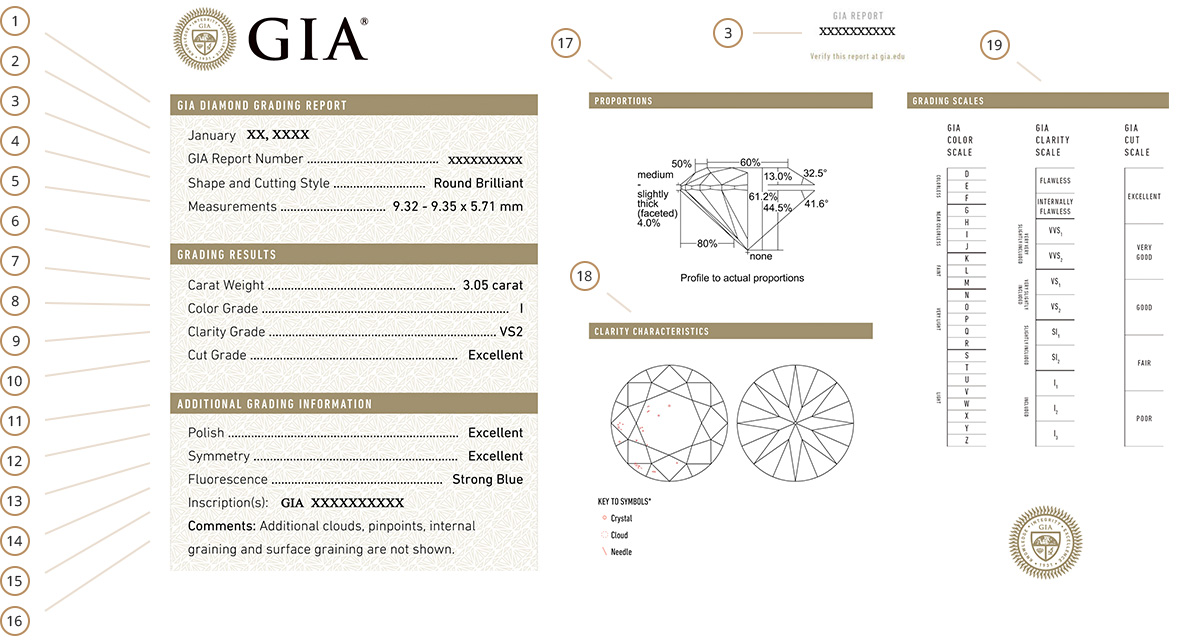
«Anatomy» of a gemological report«Diamond Grading Report»:
- Report format
- Date
- Number
- Shape and style of cut
- Measurements
- Qualitative results – «4С» (7-10)
- Carat weight
- Color characteristic
- Clarity characteristic
- Cut characteristic
- Additional Information (12-16)
- Polishing characteristic
- Symmetry characteristic
- Fluorescence characteristic
- Laser inscription on the girdle of a diamond
- Comments
- Proportions chart
- Identity chart (Plotting)
- Details of the grading system
(Evaluative mini-format) in contrast to the full-length one, it does not contain an inclusion diagram, the identified purity factors are indicated as an enumeration in the comments (the main determining factors in the number of not more than four are given). Also, upon receipt of this format of an expert opinion, laser inscription on a diamond girdle is possible. There is no identity diagram in this format, but an aspect ratio diagram. The report is available for stones weighing from 0.15 to 1.99 carats inclusive.
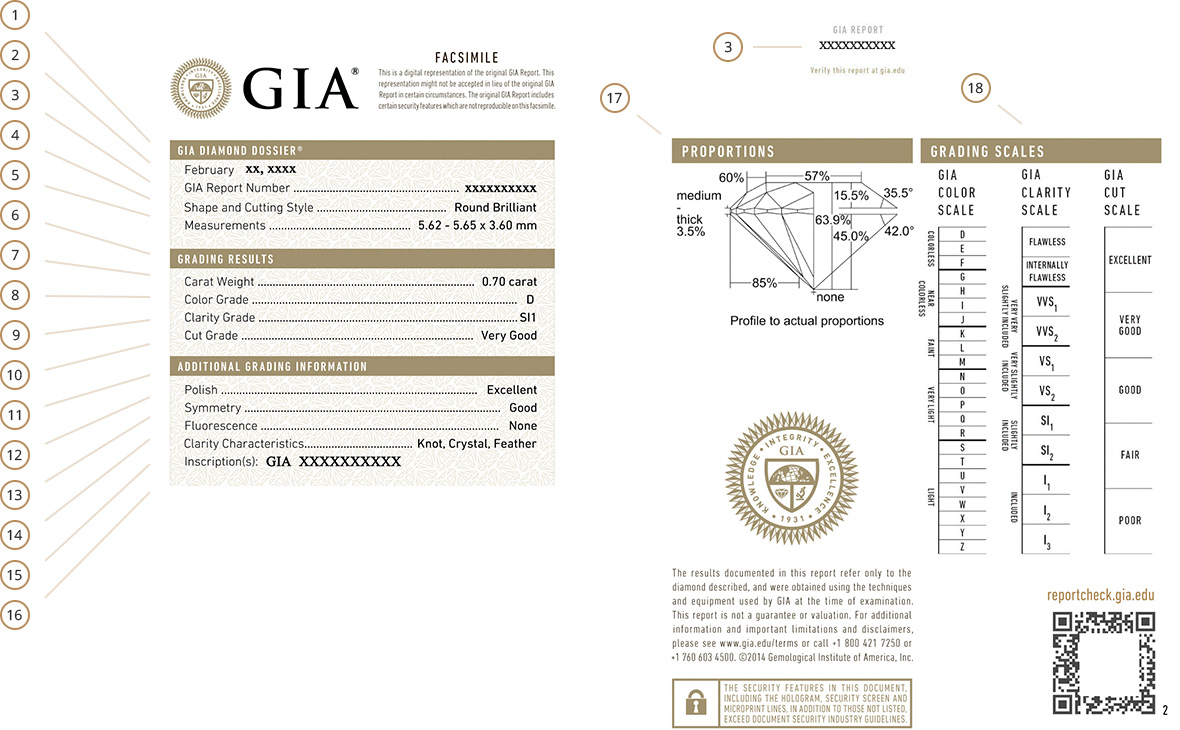
«Anatomy» of a gemological report «Diamond Dossier»:
- Report format
- Date
- Number
- Shape and style of cut
- Measurements
- Qualitative results – «4С» (7-10)
- Carat weight
- Color characteristic
- Clarity characteristic
- Cut characteristic
- Additional Information (12-16)
- Polishing characteristic
- Symmetry characteristic
- Fluorescence characteristic
- Diamond clarity factors
- Laser inscription on the girdle of a diamond
- Proportions chart
- Details of the grading system
(Evaluative in electronic format with digital photo image). This format is only available for natural, non-refined stones weighing from 0.15 to 2.99 carats. Contains only a proportion chart. The photographic image is accompanied by a description of the factors of purity and an indication of their location. The report format does not provide for reflection in the form of a document on paper.

«Anatomy» of an electronic gemological report «Diamond eReport»:
- Report format
- Date
- Number
- Shape and style of cut
- Mesurements
- Qualitative results – «4С» (7-10)
- Carat weight
- Color characteristic
- Clarity characteristic
- Cut characteristic
- Additional Information (12-16)
- Polishing characteristic
- Symmetry characteristic
- Fluorescence characteristic
- Comments
- Important conditions and restrictions
- Digital photography
- Marker description of the clarity factors
- Marker proportion charts
- Marker information about the grading system
- Marker report format information
- Marker information on the Gemological Institute of America (GIA)
(Evaluative in electronic format). This format is available for stones weighing from 0.15 to 0.39 carats, there are no diagrams of identity and proportions. The report format does not provide for reflection in the form of a document on paper. The format option includes the application of laser inscription on the surface of the diamond girdle.
GIA’s gemological reports on colored and fancy colored diamonds (“Colored Diamond”) from natural diamonds determine the nature of the diamond's origin, and the fact that signs of refining are detected (as indicated in the comments). At the request of the client, a full-color photo image of a diamond can be included in the reports, and the option of applying a laser engraving on the girdle surface is also provided.
Reports for fancy color diamonds are produced in two formats:
(Identification and Origin), This format provides information on the weight, linear dimensions, color of the diamond, as well as the source of the origin of the color (natural or refining) and the nature of its distribution. This report is performed for diamonds of any size, including in the setting.
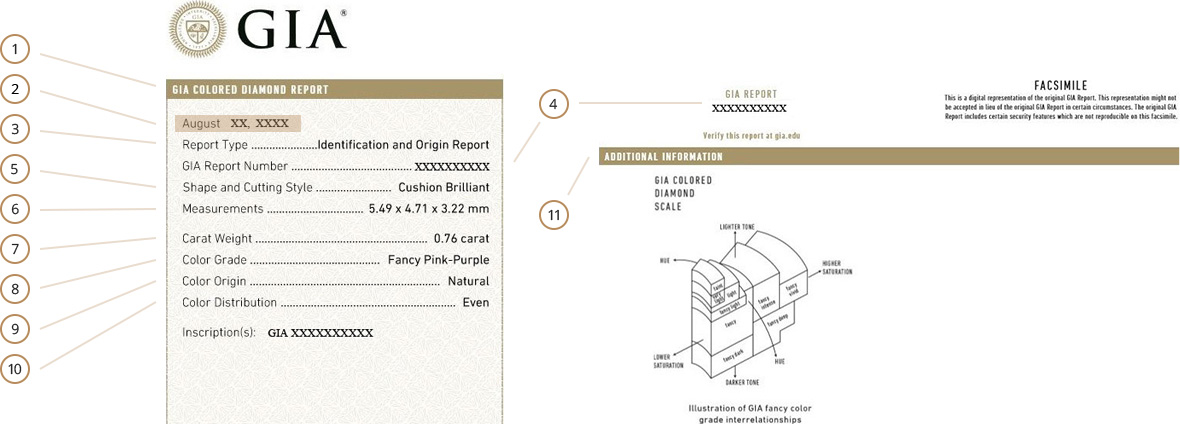
«Anatomy» of a gemological report «Colored Diamond Identification and Origin»:
- Report type (Colored Diamond Report)
- Date
- Report format (Identification and Origin Report)
- Number
- Shape and style of cut
- Measurements
- Carat weight
- Color characteristic
- Nature of color
- Color distribution
- Additional information (Proportion chart)
(Estimated), This format provides information on the main evaluation characteristics of a diamond – «4С» – Color, with indicating the source of origin of the coloration (Natural or Refining) and the nature of its distribution, Clarity, Cut, Carat Weight. In addition to the main estimated characteristics are additional – luminescence parameters in long wavelength (365 nm, with a radiation source power of 4–8 W) ultraviolet light, surface polishing quality, and brilliant cut symmetry. At the same time, an identity diagram is performed – plotting and proportion chart. For examination, stones are provided only in a loose form. The report is performed for loose stones of at least 0.15 carats in size.
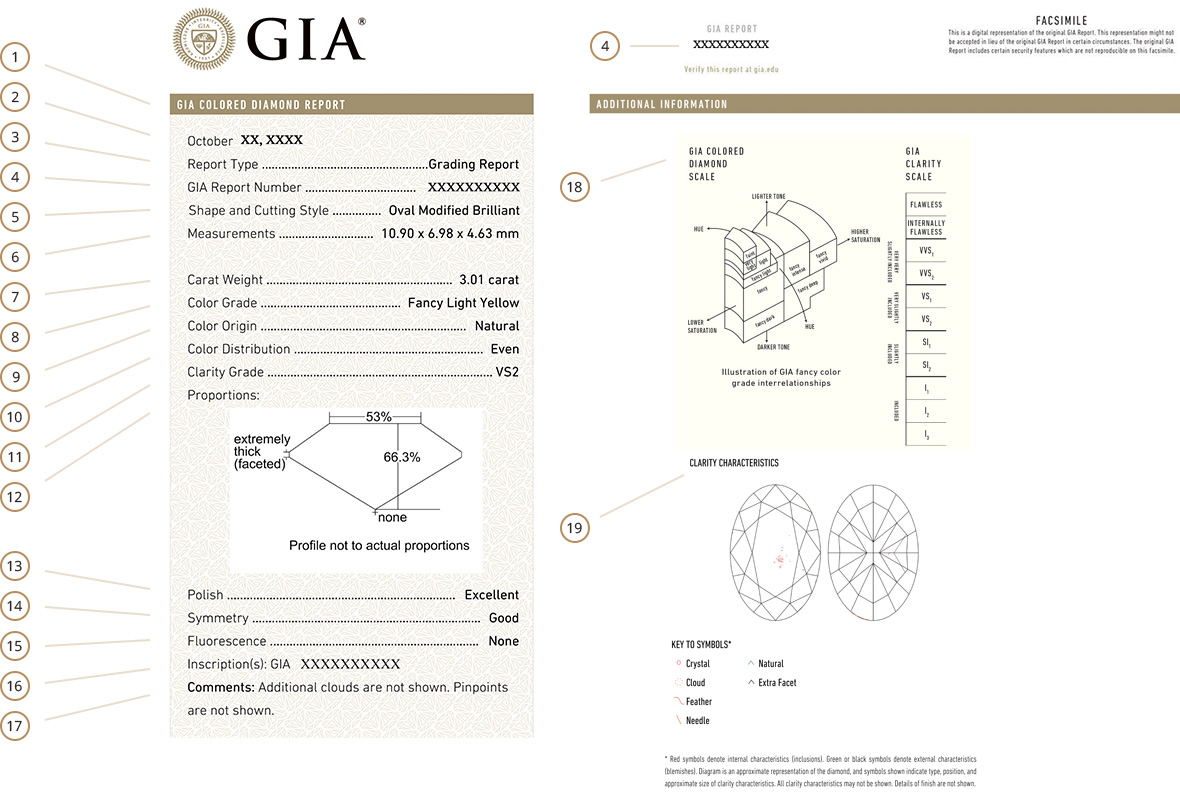
«Anatomy» of a gemological report «Colored Diamond Grading Report»:
- Report type (Colored Diamond Report)
- Date
- Report format
- Number
- Shape and style of cut
- Measurements
- Carat weight
- Color characteristic
- Nature of color
- Color distribution
- Clarity characteristic
- Proportions chart
- Polishing characteristic
- Symmetry characteristic
- Fluorescence characteristic
- Laser inscription on the girdle of a diamond
- Comments
- Details of the grading system
- Identity chart (plotting)
GIA gemological reports for diamonds from synthetic diamonds that are loose and set into jewelry («Synthetic Diamond»).
All report formats for synthetic diamonds provide for the possibility of applying laser inscription on the surface of the diamond girdle with the number and inscription "LABORATORY GROWN". Reports for synthetic diamonds are made in three formats:
(Estimated full-length for synthetic diamond). The report is performed for loose diamonds from synthetic diamonds weighing from 0.15 carats. The report identifies the nature of the diamond’s origin (synthetic), discloses information on the main estimated characteristics of the diamond – Color and Clarity, determined by a rating scale for synthetic diamonds, as well as the characteristics Cut and Carat Weight. A general cut estimate is given only for round stones of a standard brilliant cut. In addition to the main estimated characteristics «4С» additional – luminescence parameters in the long-wavelength (365 nm, with a radiation source power of 4–8 W) ultraviolet light, surface polishing quality and diamond cutting symmetry are given. At the same time, an identity diagram (location of major defects) is performed – plotting and proportion chart.
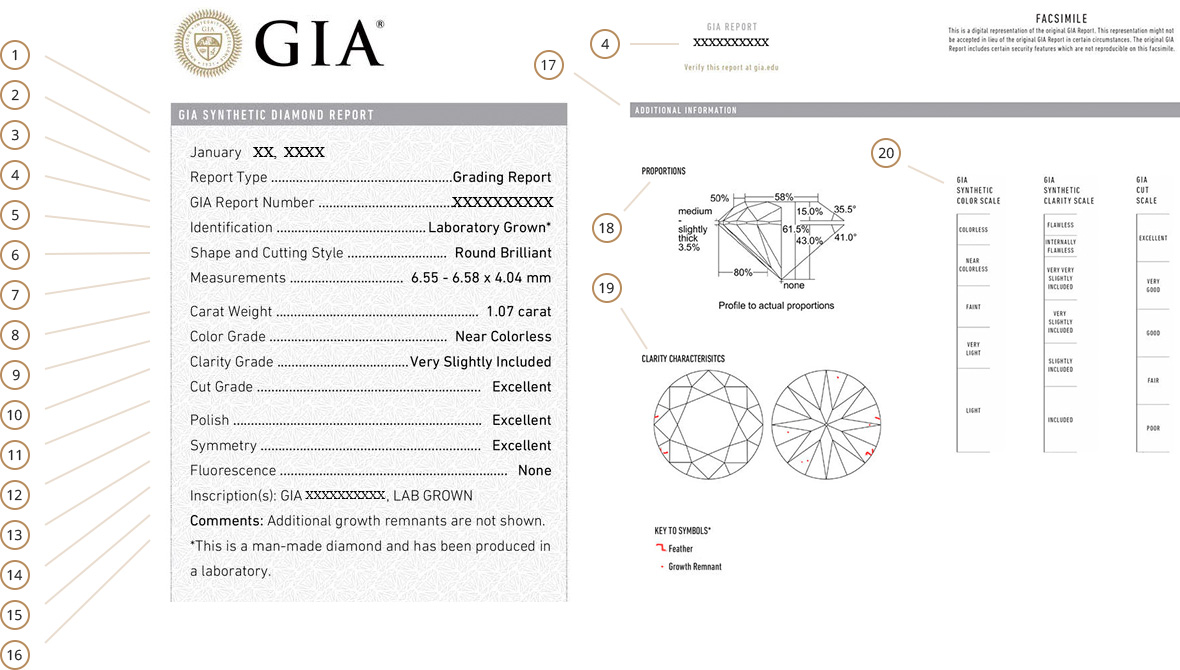
«Anatomy» of a gemological report «Synthetic Diamond Grading Report»:
- Report format
- Date
- Report type (Grading Report)
- Number
- Identification of the origin (Laboratory grown)
- Shape and style of cut
- Measurements
- Carat weight
- Color characteristic
- Clarity characteristic
- General characteristics of the cut (for round diamonds)
- Polishing characteristic
- Symmetry characteristic
- Fluorescence characteristic
- Laser inscription on the girdle of a diamond
- Comments
- Additional Information (18-20)
- Proportions chart
- Identity chart (plotting)
- Details of the grading system
(Estimated full-length for colored synthetic diamond). The report is performed for loose diamonds from synthetic diamonds weighing from 0.15 carats. The report identifies the nature of the diamond’s origin (synthetic), discloses information on the main estimated characteristics of the diamond – Color and Clarity, determined by a rating scale for synthetic diamonds, as well as Carat Weight. In addition to the main estimated characteristics, «4С» additional – luminescence parameters in the long-wavelength (365 nm, with a source power of 4-8 W) ultraviolet light are given, the surface polishing quality and the brilliant-cut symmetry are indicated. At the same time, an identity diagram (location of major defects) is performed – plotting and proportion chart.
(Identification for a colored synthetic diamond). The report is carried out both for loose diamonds and for those installed in jewelry. The report format contains information on the style and shape of the cut, a general description of coloring, linear dimensions and cut parameters; for loose diamonds, the weight of the stone is indicated.
GIA gemological reports for colored stones (Colored Stone Report)
All gemological reports for colored stones (Colored Stone Report) are performed for stones of any size, both fixed in the jewel and in free form.
The content of the reports determines the mineral type and type of the object of examination. The report contains information on the nature of origin and the availability of refining, indicating the main evaluation and identification characteristics - color, transparency, weight, size, shape and style of cut. Mandatory is a full color image of the stone.
Reports are performed in two formats:
(Color Stone Identification). It is carried out for all jewelry stones.
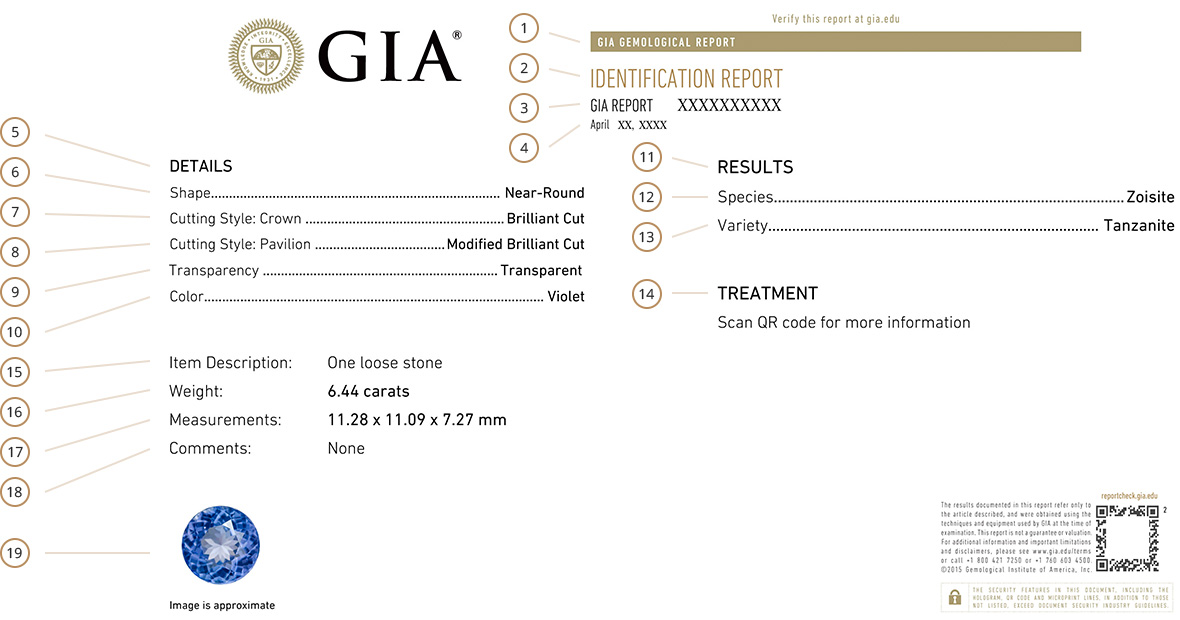
«Anatomy» of a gemological report «Colored Stone Identification Report»:
- Report type (Colored Stone Report)
- Report format (Identification Report)
- Number
- Data
- Detailing (6-10)
- Shape
- Crown cut style
- Pavilion cut style
- Transparency
- Color
- Grading results (12-14)
- Mineral type
- Mineral variety
- Availability of refining
- General description of the subject
- Weight
- Measurements
- Comments
- Photographic examination subject
(Identification and Definition of the area of origin of colored stone). Performed for rubies, sapphires, tourmaline types «параиба» and red spinel. In addition to the above-mentioned basic evaluation and identification characteristics, it includes the determination of the region of origin of the natural stone (in the event that the clip in the product allows for the study).
Additionally, for rubies and sapphires, the option of applying a laser inscription on the stone girdle is available, the report verification option is available on request.
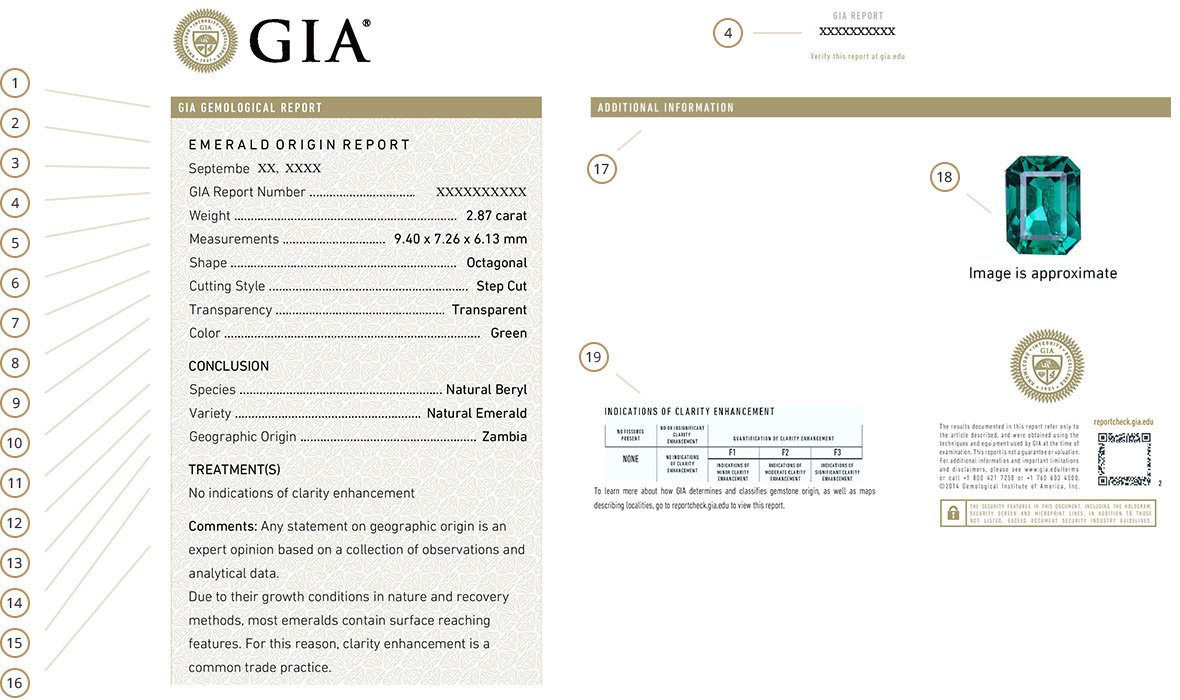
«Anatomy» of a gemological report «Colored Stone Identification & Origin Report»:
- Report type (Gemological Report)
- Report format (Emerald Origin Report)
- Date
- Number
- Weight
- Measurements
- Shape
- Cut style
- Transparency
- Color
- Grading results (12-14)
- Mineral type
- Mineral variety
- Geographical area
- Treatment
- Comments
- Additional Information (18-19)
- Photographic examination subject
- Classification of treatment
GIA gemological reports for pearls (Pearl Reports)
All gemological reports for pearls (Pearl Reports) contain a description of the type of pearls (pearls without damage, drilled pearls, ticking pearls, etc.), determining the nature of its origin (imitation, cultured, natural) and varieties (habitat and type of mollusk ) information on the availability, size, shape, color, as well as a full-color photograph.
The report is performed in two formats:
(Identificational). It is performed for all types of pearls. For the examination is taken as a pearl, enshrined in the jewelry, and in free form.
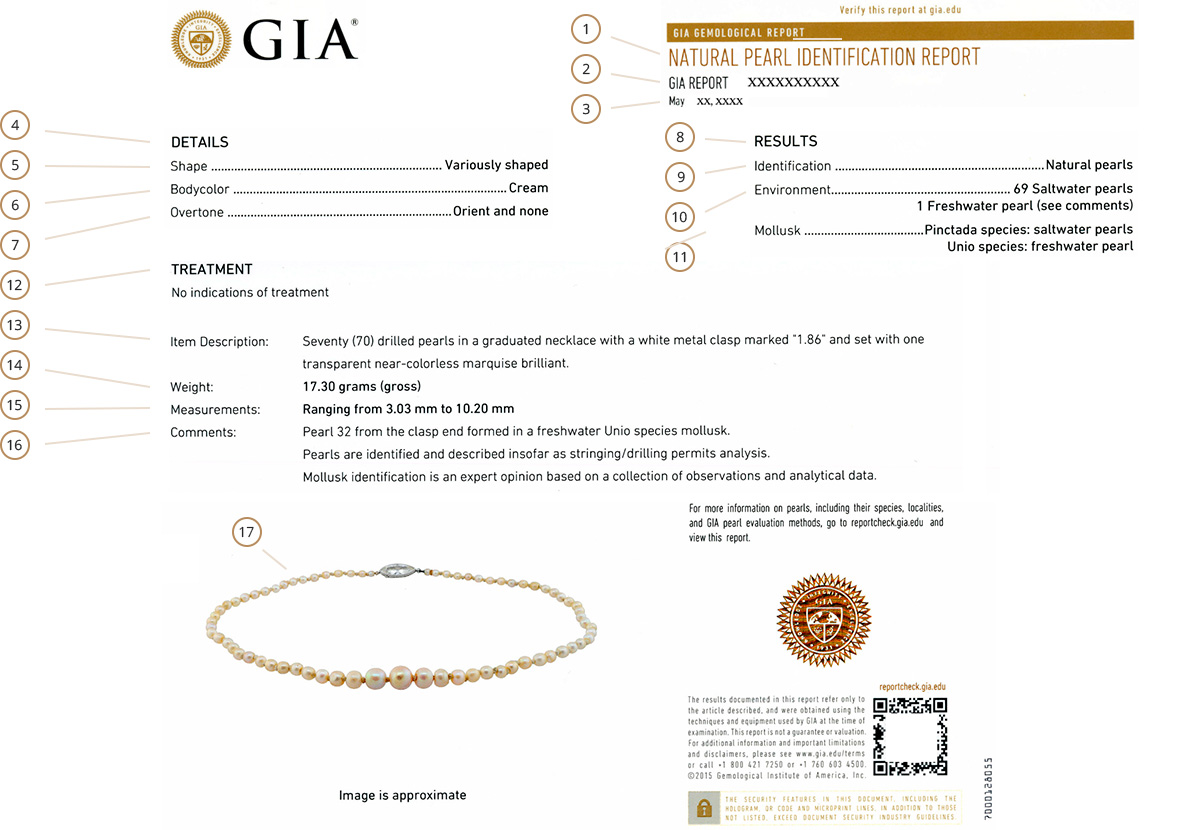
«Anatomy» of a gemological report «Pearl Identification Report»:
- Report format (Pearl Identification Report)
- Number
- Date
- Special features (5-7)
- Shape
- Main color
- Ovartone
- Grading results (9-11)
- Definition
- Produsent habitat
- Podutsent (biological species of mollusk)
- Treatment
- Description of the subject matter
- Weight
- Measurements
- Comments
- Photo
(Estimated). It is performed only for pearl pearls and includes information on the main evaluation characteristics: gloss, surface defects, selection of pearls.
Additional reports
GIA Gemological Institute for diamonds, colored stones and pearls, as well as products with them, provides additional report formats:
(Information mail) – a document supplementing the standard gemological report and disclosing information on individual stones or pearls in a product, or on some phenomenal properties of a pearl or stone, which potentially increase the attractiveness of the subject matter of the examination.
(Report «PORTRAIT ™», Individualized report) – a document characterized by the presence of a hard cover, high quality printing performance, and containing all the main characteristics of the stone or pearl provided for a full-size assessment report or a report on identification and determination of the area of origin, accompanied by a high-resolution photograph.
(Report «MONOGRAPH ™») – The document, made in the form of a separate edition with high quality printing, in hardcover, designed for outstanding diamonds, colored stones and pearls. The report is characterized by a complete description of the stone or pearl being investigated, including a detailed description of the evaluation characteristics, analysis results (including spectral), a history of the subject of the examination, as well as other information important for the presentation of the stone or pearl.

